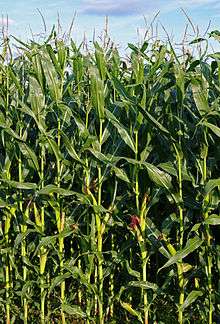Diffuse sky radiation

Diffuse sky radiation is solar radiation reaching the Earth's surface after having been scattered from the direct solar beam by molecules or particulates in the atmosphere. Also called sky radiation, diffuse skylight, or just skylight, it is the reason for the color changes of the sky. Of the total light removed from the direct solar beam by scattering in the atmosphere (approximately 25% of the incident radiation when and where the Sun is high in the sky, depending on the amount of dust, haze, and other particulates in the atmosphere), about two-thirds ultimately reaches the earth as diffuse sky radiation. When the Sun is at the zenith in a cloudless sky, with 1361 W/m2[1] above the atmosphere, direct sunlight is about 1050 W/m2, and total insolation about 1120 W/m2.[2] This implies that under these conditions the diffuse radiation is only about 70 W/m2 out of the original 1361 W/m2.
The dominant radiative scattering processes in the atmosphere (Rayleigh scattering and Mie scattering) are elastic in nature, by which light can be deviated from its path without being absorbed and with no change in wavelength.
Color
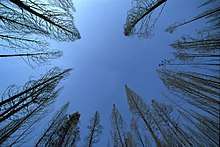
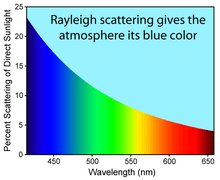
The sunlit sky is blue because air scatters short-wavelength light more than longer wavelengths. Since blue light is at the short-wavelength end of the visible spectrum, it is more strongly scattered in the atmosphere than long-wavelength red light. The result is that when looking toward parts of the sky other than the sun, the human eye perceives them to be blue.[3] The color perceived is similar to that obtained by a monochromatic blue of a wavelength of 474–476 nm mixed with white light, i.e., an unsaturated blue light.[4] The explanation of the blue color by Rayleigh in 1871 is one of the most famous examples of the application of dimensional analysis in solving a problem in physics.[5]
Near sunrise and sunset, most of the sunlight arrives nearly tangentially to the Earth's surface; thus, the light's path through the atmosphere is so long that much of the blue and even green light is scattered out along the way, leaving the sun rays and the clouds it illuminates red. Therefore, when looking at the sunset and sunrise, we see the color red more than the other colors.
Scattering and absorption are major causes of the attenuation of radiation by the atmosphere. Scattering varies as a function of the ratio of the particle diameter to the wavelength of the radiation. When this ratio is less than about one-tenth, Rayleigh scattering occurs. In this case, the scattering coefficient varies inversely with the fourth power of the wavelength. At larger ratios, scattering varies in a complex fashion, described for spherical particles by the Mie theory; the laws of geometric optics begin to apply at a ratio of the order of 10.
In the example of the sky at the zenith, it is blue during broad daylight due to Rayleigh scattering involving diatomic gases (N
2, O
2). Near sunset and especially during twilight, ozone (O
3) absorption significantly contributes to maintaining the sky's blue color.
Neutral points
There are four commonly detectable points of zero polarization of diffuse sky radiation (known as neutral points) lying along the vertical circle through the sun.
- The Arago point, named after its discoverer, is customarily located at about 20° above the antisolar point; but it lies at higher altitudes in turbid air. The latter property makes the Arago distance a useful measure of atmospheric turbidity.
- The Babinet point, discovered by Jacques Babinet in 1840, is located about 15° to 20° above the sun, hence it is difficult to observe because of solar glare.
- The Brewster point, discovered by David Brewster in 1840, is located about 15° to 20° below the sun; hence it is difficult to observe because of solar glare.
- The fourth point, located at about 20° below the antisolar point, visible only at higher altitudes in the air or in space.[6]
Under an overcast sky
There is essentially no direct sunlight under an overcast sky, so all light is then diffuse sky radiation. The flux of light is not very wavelength dependent because the cloud droplets are larger than the light's wavelength and scatter all colors approximately equally. The light passes through the translucent clouds in a manner similar to frosted glass. The intensity ranges (roughly) from 1⁄6 of direct sunlight for relatively thin clouds down to 1⁄1000 of direct sunlight under the extreme of thickest storm clouds.
As a part of total radiation
One of the equations for total solar radiation is:[7]
where Hb is the beam radiation irradiance, Rb is the tilt factor for beam radiation, Hd is the diffuse radiation irradiance, Rd is the tilt factor for diffuse radiation and Rr is the tilt factor for reflected radiation.
Rb is given by:
where δ is the solar declination, Φ is the latitude, β is an angle from the horizontal and h is the solar hour angle.
Rd is given by:
and Rr by:
where ρ is the reflectivity of the surface.
Eruption of Mt. Pinatubo and agriculture
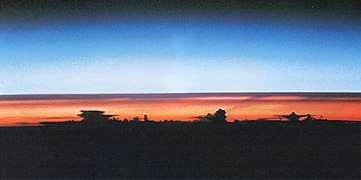
The eruption of the Philippines volcano - Mount Pinatubo in June 1991 ejected roughly 10 km3 (2.4 cu mi) of magma and "17,000,000 metric tons"(17 teragrams) of sulfur dioxide SO2 into the air, introducing ten times as much total SO2 as the 1991 Kuwaiti fires,[8] mostly during the explosive Plinian/Ultra-Plinian event of June 15, 1991, creating a global stratospheric SO2 haze layer which persisted for years. This resulted in the global average temperature dropping by about 0.5 °C (0.9 °F).[9] As volcanic ash falls out of the atmosphere rapidly,[10] the negative agricultural effects of the eruption were largely immediate and localized to a relatively small area in close proximity to the eruption, as they were caused by the resulting thick ash cover that resulted.[11][12] Globally however, despite a several-month 5% drop in overall solar irradiation, and a reduction in direct sunlight by 30%,[13] there was no negative impact to global agriculture.[14][15] Surprisingly, a 3-4 year[16] increase in global Agricultural productivity and forestry growth was observed, excepting boreal forest regions.[17]
The means by which this was discovered, is that initially at the time, a mysterious drop in the rate at which carbon dioxide (CO2) was filling the atmosphere was observed, which is charted in what is known as the "Keeling Curve".[18] This led numerous scientists to assume that this reduction was due to the lowering of the Earth's temperature, and with that, a slow down in plant and soil respiration, indicating a deleterious impact to global agriculture from the volcanic haze layer.[14][15] However upon actual investigation, the reduction in the rate at which carbon dioxide filled the atmosphere did not match up with the hypothesis that plant respiration rates had declined.[19][20] Instead the advantageous anomaly was relatively firmly[21] linked to an unprecedented increase in the growth/net primary production,[22] of global plant life, resulting in the increase of the carbon sink effect of global photosynthesis.[14][15] The mechanism by which the increase in plant growth was possible, was that the 30% reduction of direct sunlight can also be expressed as an increase or "enhancement" in the amount of diffuse sunlight.[14][19][23][15]
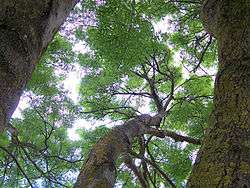
This diffuse light, owing to its intrinsic nature, can illuminate under-canopy leaves permitting more efficient total whole-plant photosynthesis than would otherwise be the case.[14][15] In stark contrast to the effect of totally clear skies and the direct sunlight that results from it, which casts shadows onto understorey leaves, strictly limiting plant photosynthesis to the top canopy layer.[14][15] This increase in global agriculture from the volcanic haze layer also naturally results as a product of other aerosols that are not emitted by volcanoes, such as man-made "moderately thick smoke loading" pollution, as the same mechanism, the "aerosol direct radiative effect" is behind both.[17][24][25]
See also
References
- ↑ Coddington, O; Lean, J. L; Pilewskie, P; Snow, M; Lindholm, D (2016). "A Solar Irradiance Climate Data Record". Bulletin of the American Meteorological Society. 97 (7): 1265. Bibcode:2016BAMS...97.1265C. doi:10.1175/BAMS-D-14-00265.1.
- ↑ "Introduction to Solar Radiation". Newport Corporation. Archived from the original on October 29, 2013.
- ↑ "Rayleigh scattering." Encyclopædia Britannica. 2007. Encyclopædia Britannica Online. retrieved November 16, 2007.
- ↑ Glenn S. Smith, (July 2005). "Human color vision and the unsaturated blue color of the daytime sky" (PDF). American Journal of Physics. 73 (7): 590–597. Bibcode:2005AmJPh..73..590S. doi:10.1119/1.1858479.
- ↑ "Craig F. Bohren, "Atmospheric Optics", Wiley-VCH Verlag GmbH, page 56" (PDF). wiley-vch.de. Retrieved April 4, 2018.
- ↑ Horváth, G; Bernáth, B; Suhai, B; Barta, A; Wehner, R (October 2002). "First observation of the fourth neutral polarization point in the atmosphere". Journal of the Optical Society of America A. 19 (10): 2085–99. Bibcode:2002JOSAA..19.2085H. doi:10.1364/JOSAA.19.002085. PMID 12365628.
- ↑ Mukherjee, D. (April 4, 2018). "Fundamentals of Renewable Energy Systems". New Age International. Retrieved April 4, 2018 – via Google Books.
- ↑ John C McCain; Muhammad Sadiq; M Sadiq (1993). The Gulf War Aftermath: An Environmental Tragedy. Springer. p. 60. ISBN 0-792-32278-9.
- ↑ "Mt. Pinatubo's cloud shades global climate". Science News. Retrieved 2010-03-07.
- ↑ Program, Volcano Hazards. "Hawaiian Volcano Observatory". hvo.wr.usgs.gov. Retrieved April 4, 2018.
- ↑ "Mercado". pubs.usgs.gov. Retrieved April 4, 2018.
- ↑ "Mt. pinatubo (LK): Biosphere - ESS". sites.google.com. Retrieved April 4, 2018.
- ↑ "Cooling Following Large Volcanic Eruptions Corrected for the Effect of Diffuse Radiation on Tree Rings. Alan Robock, 2005. See Figure 1 for a graphic of the recorded change in solar iiradiation" (PDF). rutgers.edu. Retrieved April 4, 2018.
- 1 2 3 4 5 6 "Large Volcanic Eruptions Help Plants Absorb More Carbon Dioxide From the Atmosphere : News". archive.org. March 16, 2010. Retrieved April 4, 2018.
- 1 2 3 4 5 6 LARGE VOLCANIC ERUPTIONS HELP PLANTS ABSORB MORE CARBON DIOXIDE FROM THE ATMOSPHERE
- ↑ Self, S. (August 15, 2006). "The effects and consequences of very large explosive volcanic eruptions". Philosophical Transactions of the Royal Society of London A: Mathematical, Physical and Engineering Sciences. 364 (1845): 2073–2097. Bibcode:2006RSPTA.364.2073S. doi:10.1098/rsta.2006.1814. PMID 16844649. Retrieved April 4, 2018 – via rsta.royalsocietypublishing.org.
- 1 2 Evaluating aerosol direct radiative effects on global terrestrial ecosystem carbon dynamics from 2003 to 2010. Chen et al., Tellus B 2014; 66, 21808, Published by the international meteorological institute in Stockholm.
- ↑ "Cooling Following Large Volcanic Eruptions Corrected for the Effect of Diffuse Radiation on Tree Rings. Alan Robock, 2005. See Figure 2 for a record of this" (PDF). rutgers.edu. Retrieved April 4, 2018.
- 1 2 L., Gu,; D., Baldocchi, (December 1, 2001). "Roles of volcanic eruptions, aerosols and clouds in global carbon cycle". AGU Fall Meeting Abstracts. Bibcode:2001AGUFM.B51A0194G.
- ↑ "Response of a Deciduous Forest to the Mount Pinatubo Eruption: Enhanced Photosynthesis. Gu et al., 28 March 2003 Journal of Science Vol 299" (PDF). utoledo.edu. Retrieved April 4, 2018.
- ↑ "CO2 Science". www.co2science.org. Retrieved April 4, 2018.
- ↑ http://earthobservatory.nasa.gov/Features/GlobalGarden/ Global Garden gets greener. NASA 2003
- ↑ "Cooling Following LargeVolcanic Eruptions Corrected for the Effect of Diffuse Radiation on Tree Rings. Alan Robock, 2005. Figure 1" (PDF). rutgers.edu. Retrieved April 4, 2018.
- ↑ Impact of atmospheric aerosol light scattering and absorption on terrestrial net primary productivity, Cohan et al. GLOBAL BIOGEOCHEMICAL CYCLES 2002 VOL. 16, NO. 4, 1090, doi:10.1029/2001GB001441
- ↑ Direct observations of the effects of aerosol loading on net ecosystem CO2 exchanges over different landscapes. Niyogi et al. Geophysical Research Letters Volume 31, Issue 20, October 2004 doi:10.1029/2004GL020915
Further reading
- Pesic, Peter (2005). Sky in a Bottle. The MIT Press. ISBN 978-0-262-16234-0.
